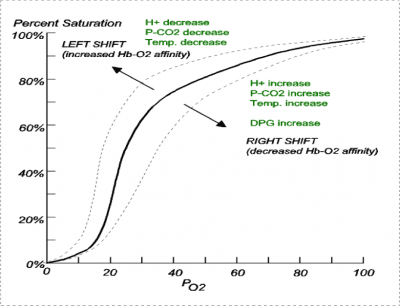Do We Understand Oxygenation?


The Oxyhemoglobin Dissociation Curve can be confusing… However, it’s essential to understand oxygen physiology in critical care. Think of it as a “Manual for Dating.” In a healthy relationship, you have a good date, and really like that person, but don’t mind dropping them off after an evening out because you know you’ll see them again. Hemoglobin picks up and drops off O2 when needed. (Normal Curve)
In another scenario, you pick up your dates but don’t like them too much, so you can’t wait to get the date over. You drop them off fast! In a Right shift, hemoglobin has less of an affinity for O2. This means that the O2 can’t attach and be stored before the hemoglobin dumps into the tissues. You have a resulting lower than normal SaO2 but excellent tissue oxygenation (PaO2). In this situation, think about everything that’s raised:
In contrast, when looking at the Left shift, you pick up your date, like them a lot, but you’re insecure and don’t want to drop them off. Jealousy!! Left shifts have a higher affinity for O2 and won’t let the O2 be dumped off to the tissues. This gives you a falsely high SaO2 and poor tissue oxygenation (PaO2). Remember, your SaO2 is a reflection of the amount of O2 bound to Hgb. If your Hgb is holding onto all the O2 stores and not releasing them, you’ll have a highly saturated Hgb. But poor tissue oxygenation. Jealousy is BAD! In this situation, think everything Low:
My question is this! Should we rely on our SaO2? Does it really tell the story of oxygenation status? What’s the best monitoring tool we have?
Further Reading:
Article on massive transfusion of PRBC and effects on 2-3 DPG and oxygenation
Pohlman. Damage control resuscitation. Blood Rev 2015; published January 17th

Eric Bauer, MBA, FP-C, CCP-C, C-NPT, EMT-P, internationally recognized best-selling author, speaker, and educator and holds a Bachelor’s Degree in Business – Health Care Administration and a Master’s of Business Administration – MBA. He has spoken on many critical care topics as an educator and has authored and published 208 critical care podcasts related to the pre-hospital critical care industry, with over 4 million downloads to date. Eric was awarded the 2017 EMS WORLD Innovation Award for his Ventilator Management: A Pre-hospital Perspective book and Ventilator Management Course and was the recipient of the 2018 John Jordan Award For Excellence in Transport Medicine Journalism by the Air & Surface Transport Nurses Association.
